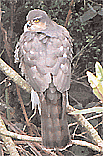|
Wildlife
Newsletter for the Township of Dalkey May 2013 - Michael Ryan |
THE
EARLY BIRD CATCHES THE COLD We were walking on the Killiney Bay side of the hill which is usually sheltered from the worst winds but this day offered no shelter from the bitter east wind that seemed to have been blowing for weeks. Less then a hundred miles north, farmers were digging out sheep from deep snow drifts, some alive but many dead, after experiencing some of the worst weather ever for a time of year, normally a time when newly born lambs could be expected to be finding their feet in the spring sunshine. Here we’d escaped the snow and the power cuts but still had the bone chilling cold winds. I had just been thinking that despite the heavy snow covering much of the UK and Ireland early Swallows and Sand Martins would surely already have been seen. Arriving early is a gamble for migrant birds, the advantage being they can get to a good nesting site and claim it before other birds of the same species arrive, the disadvantage being the chance they’ve came while the weather is still bad. If it is bad, cold or very wet, there’s likely to be very few insects around for these aerial hunters to feed on and it’s hard to imagine this year’s weather could be any worse for them. |
|
Would
they turn around and fly back south to warmer regions or try to find
some meagre food on coasts or in milder pockets of land. Or would they
gradually weaken and die, a tragic end to a journey of thousands of
miles. At this stage our walk had brought us into the shelter of a fence
and trees when a bird shot past us into the brambles ahead of us. It
was small and initial impression was of a light colour bird, almost
yellow. My companion saw it too and noted it had dark legs almost certainly
confirming its identification as a chiffchaff. Chiffchaff are another
early migrant species but unlike the swallows and martins they would
feed on insects in bushes and woodlands rather then in the air. Hopefully
it will be able to find enough to eat in th undergrowth. The northerly
winds may have slowed down the arrival of some migrants but you could
only hope for the best for those that had already arrived. |
|
| SONGBIRD
SLAUGHTER |
|
|
|
 |
There’s
a very high mortality rate for young and juvenile birds most not even
surviving to their first birthday but it would seem that if a bird exceeds
a certain average age it can live considerably longer, benefitting from
its experience and refining its survival skills. This is where ringing birds can provide some very interesting information and a list of longest living birds recorded provides some fascinating facts. Some of the birds would have been ringed as chicks in the nest but others would have been caught as adults so the researcher would know only what their minimum age was meaning they could even be older then recorded. Some of the record oldest birds were caught alive and some were found dead. A robin that was found dead in the Czech Republic had achieved the grand age of 19 years and 4 months. A blackbird in Germany was still alive when its age was recorded as 21 years 10 months. Another common garden bird, the dunnock, had at least one of its species live to 20 years 10 months. A lot of people wouldn’t be happy to learn that a magpie had managed to live to the age of 21yrs 8mths before being shot. As for sparrowhawks, in Denmark the remains was found of one who had lived to 20 years and three months. |